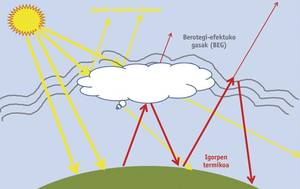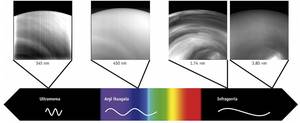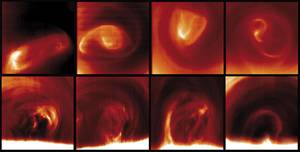Planetary atmospheres: the case of Venus

Venus is the second closest planet to the Sun, which operates in an almost circular orbit at a distance of 0.72 AU (astronomical unit, average distance between Earth and the Sun, almost 150 million kilometers). The time Venus takes to turn around the Sun (224.7 days on Earth) is shorter than its rotation period (243 days on Earth). That is, in Venus the year is shorter than the day. The axis of rotation of the planet is almost perpendicular to the ecliptic, to the plane that defines the Ecuador of the Sun. Therefore, Venus has no seasons and turns in the opposite direction to the other planets of the Solar System (see figure 1).
Venus is very similar in many respects to the Earth, for example, by its size (the radius of Venus is 95% of the Earth) and by its mass (96.1%). But on other occasions, both planets have nothing to do with, for example, the atmosphere. The earth is composed mainly of nitrogen (N 2, 78.1%) and oxygen (0 2, 21%). That of Venus, on the other hand, is carbon dioxide (CO 2, 96.5%) and nitrogen (N 2, 3.5%), and the presence of water is only 20 ppm (parts per million). This makes the atmosphere of Venus much denser and hotter. In fact, the atmospheric pressure on the surface is 90 bar, 90 times higher than on the ground surface, and the temperature is 460 °C. If this were not enough, the clouds are sulfuric acid, so the rain is very corrosive, but due to the high temperatures it evaporates before reaching the surface. These extreme conditions make exploration of the surface very difficult. Only the Venera space probes of the 70's have managed to stand on the surface and not exceed 110 minutes of activity.
Greenhouse effect Greenhouse effect
Some gases potentially present in the atmosphere, such as carbon dioxide, methane and water vapor, cause the greenhouse effect on several planets. Solar radiation is almost entirely within the visible spectrum, and since the aforementioned gases do not absorb these wavelengths, light can reach the surface without obstacles and increase its temperature. On the other hand, the heat that the surface of the planet emits to space, the thermal radiation, is placed in the infrared spectrum, and since the aforementioned gases can absorb those wavelengths, the radiation is "trapped" in the atmosphere, increasing the temperature even more.
Both on Earth and on Venus there is a greenhouse effect, but there are two great differences. On the one hand, CO 2 and the amount of water vapor present in the Earth's atmosphere are very low compared to CO 2 of Venus. And on the other hand, the Earth has water; the oceans have the ability to destroy CO 2, they somewhat balance the greenhouse effect (at least the intrinsic part of the effect, not the one caused by man) and the average temperature on the Earth's surface is 15 °C, that is, the planet is habitable. In Venus, however, there are no oceans and the greenhouse effect causes incredible temperatures (460ºC).

However, on the surface there is carbon dioxide. In fact, as in the atmosphere of Venus there are CO 2 as carbonated minerals, so it is considered that both atmospheres, despite having the same initial conditions, suffered very different evolutions. Formerly Venus could be very similar to Earth, with lower temperatures and liquid water on the surface. At some point, the planet could begin to heat up to evaporate all surface water, which, being the most effective water vapor in the greenhouse effect than CO 2, would increase the temperature even more. Then, you could start to sublimate the carbon of the rocks and generate CO 2 more by reacting with atmospheric oxygen. By sublimating all carbon into the atmosphere, it would achieve a higher temperature and pressure balance and form the Venus we know today.
Superrotation Superrotation
In addition to the composition, the atmospheric dynamics of Venus is very different from that of Earth. On our planet, the period of rotation of the atmosphere is very similar to that of the surface, that is, the time that takes to rotate the atmosphere around the planet and the Earth itself is very similar. In Venus, the speed of the atmosphere increases with height up to 65 kilometers. There the atmosphere has a maximum speed of 360 km/h, that is, it moves 60 times faster than the surface. On Earth, however, the strongest winds only have speeds that exceed 10-20% of the planet's rotation. This phenomenon is known as superrotation, and its origin is not yet known, nor how it can be maintained.
In the Solar System there is another case of superrotation, in Titan. Titan is the largest moon of Saturn, the only one with a prominent atmosphere. As in the case of Venus, it has a slow rotation and a fast atmosphere. A day of titanium lasts 16 days terrestrial, but the winds to 125 km of height move between 8 and 9 times faster than the surface.
Ultraviolet absorbent
Another important feature of Venus is that it is completely covered with clouds. While these clouds are not isolated thick, the opacity of the entire layer of clouds that extends to an approximate height of 45-65 km prevents the observation of the one below. Currently, using the image spectrometer of the Venus Express spacecraft of the European Space Agency or a camera with specific filters, the electromagnetic spectrum of the radiation emitted by the planet is analyzed, since measuring the radiation of different wavelength can be studied the different properties and heights of the atmosphere.

For example, in the UV zone, part of the current planet, the reflected sunlight can be observed. As reflection occurs at the top of the cloud layer, ultraviolet images present the distribution of clouds at 65 km in the atmosphere (see figure 3). In fact, the bright and dark zones are interspersed in the images, indicating the existence of a powerful absorbent of still unknown ultraviolet light.
The 75% of the light that reaches Venus is reflected, but as almost all of the radiation of the Sun is visible, in those wavelengths the planet is very bright and no cloud zones are seen in the images. If we go to a longer wavelength infrared radiation, we immerse ourselves in the thermal emission spectrum. That is, in the area of radiation emitted by a body by the mere presence at a certain temperature. Therefore, the measure of a thermal emission can be adjusted to a specific temperature of the atmosphere and therefore to a height.
Thus, it is known that the emission of 1.1 µm of wavelength comes from the surface or that the radiation of 3.80 µm corresponds to the upper clouds. The spatial distribution of the clouds we see in the images, instead of indicating the direct emission of the clouds, can indicate the clouds that become a source of opacity. In the case of a radiation of 1.74 µm, for example, the emission has its origin in the lower part of the atmosphere, but in the ascension it is located with clouds located at 45 km and is partially absorbed. In other words, clouds act as filters and each one of them hinders the amount of radiation.
Polar vortex south
If the wavelengths appropriate for the observation of Venus are chosen, the images show different structures of clouds. Vortices are complex structures of cloud winds that swivel rapidly around a center. The whirlpools of water and hurricanes are an example of the violent Earth, but also the polar violins of the Arctic and Antarctica, cyclones that revolve around the poles. There are many planets in the Solar System that have polar violences. Some have a rare form, but the violin of the South Pole of Venus is the most versatile of all.

In its first tour to the planet, the spacecraft Venus Express verified that in the South Pole there was a giant vortex in the form of "double eye". Since then, the high-resolution infrared images of the VIRTIS tool have shown that this structure sometimes has dipolar shape and sometimes more rounded, although it usually has a form of transition between both configurations.
In general, although in a few days it jumps from one structure to another, some of them are stable for several days. In these cases, if clouds are considered to be passive tractors that are dragged by the wind, the wind speed can be measured. Thus, it has been observed that violence is far from the South Pole of the planet and is moving around unpredictably. This movement is of the same sense and speed as the atmosphere. Therefore, despite being small movements that constantly destroy and regenerate the structure, as a whole violence moves with the atmosphere.
The only permanent pattern is the annular structure that surrounds the vortex and is usually about 15 °C below the zone. Both the violence and persistence of the rings can indicate a dynamic relationship between the two structures, but it is not yet clear what it can be.
The dynamics of violence may be related to the superrotation of the rest of the atmosphere. Or perhaps not. More than a thousand volcanoes on the planet may participate in the cloud formation process due to a certain influence of the new particles that emit the atmosphere. Or perhaps not. The only thing that is clear is that Venus is a planet full of mystery. Therefore, it is not surprising the current curiosity about the star that has been called "our twin planet".
References References References References
Buletina
Bidali zure helbide elektronikoa eta jaso asteroko buletina zure sarrera-ontzian











